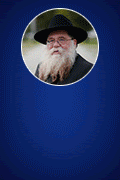In early 2002 Linda Lingle, the former mayor of Maui and then head of the Hawaii Republican Party, stopped by the seder we were running at the Chabad House in Honolulu. We had already finished the fourth cup of wine, so my husband, Rabbi Itchel Krasnjansky, duly introduced her to the guests as the “future governor of Hawaii.”
It was six months before the gubernatorial election, and she had not yet officially declared her candidacy for that office.
Lingle, who is Jewish and had known us for six months, stood by quietly and smiled.
Host In Chief
Hawaii governor makes kosher seder in her mansion an annual event.
In early 2002 Linda Lingle, the former mayor of Maui and then head of the Hawaii Republican Party, stopped by the seder we were running at the Chabad House in Honolulu. We had already finished the fourth cup of wine, so my husband, Rabbi Itchel Krasnjansky, duly introduced her to the guests as the “future governor of Hawaii.”
It was six months before the gubernatorial election, and she had not yet officially declared her candidacy for that office.
Lingle, who is Jewish and had known us for six months, stood by quietly and smiled.
My husband added, with a flourish, “And next year there will be a kosher seder in the governor’s mansion.”
I was a bit stunned, but pleased and impressed by my husband’s optimism and chutzpah.
Within a year both predictions came true. Lingle won the election, and soon enough we received a call inviting Chabad to organize a seder for some 130 guests, affiliated and unaffiliated, at the governor’s mansion, Washington Place.
We’ve held three seders there on the lanai, Hawaiian for patio, and served nearly 500 meals. We are currently preparing our fourth seder.
Preparing one’s home for Pesach and planning a seder is very daunting. Taking over the governor’s home — the kashering, the cleaning and the logistics — is an even greater feat.
There are so many rules in the protocol that must be followed, but the governor’s chef told us that when we go in, every rule is broken. One minor example: No one besides the chef is allowed to be in the kitchen for security reasons, but when we kasher it, many people come in and out.
Two days before the seder we begin setting up. We put up the outdoor tent, which functions as our de facto full-service kitchen during the seder, and take out the kosher dishes and the furniture. On the day of the seder we bring in the food.
Since the governor’s mansion does not have special amenities for netilat yadayim, the ritual hand washing before eating a meal with bread, we have to set up special Italian glass water coolers on the lanai.
The first year we conducted a seder in the mansion, we took literally truckloads of dishes, cutlery, glasses, etc., to be toyveled, ritually immersed, on the beach. We went out there with my seven children and a few volunteers, and set up three stations. We even had someone rinsing the dishes in the outdoor showers. Our unusual activity was drawing a lot of attention.
One of my daughters sidled up to me and asked, “Ma, aren’t you embarrassed? People are looking at us.”
I answered, “Hashem has created everything in the world for us to use for a higher purpose — His mitzvahs. That’s what we’re doing now. I’m proud, not embarrassed.”
I think this experience gave her a new perspective.
At our seders we have hundreds of candles — among them, the governor’s — lighting up the hall of state. In her home on Pesach, the governor is likewise a very down-to-earth, warm and friendly person, talking to my children, ages 5 to 20. An extremely gracious hostess, Governor Lingle welcomes all who come with equal warmth.
The guests are an interesting mix: some longtime Chabad regulars, friends and staff members of the governor, some political figures, and Jewish people who otherwise would not attend a Chabad seder but are honored to be part of this historic gathering.
After everyone leaves at the end of the seder, I stay with my older children and the wait staff to clean up, pack all the equipment and make sure it all goes back to its right place. Last year my very attached 8-year-old daughter, Estee, refused to move without me. Last year she stayed on and rolled up her sleeves alongside the rest of us. By the time we finished and had to walk home, she was exhausted. After a few minutes of walking, at nearly 1 a.m., she began crying and refused to take another step. I could not carry her because I was exhausted, too. All I could do was tell her, “Don’t worry, Hashem will help us.”
A few moments later we found an empty shopping cart at the corner, which I used to wheel my daughter home. That Divine Providence was a perfect ending to a beautiful night.
Even more inspiring than the seders is the transformation my husband and I have witnessed in the governor. Previously she had a tangential connection to Jewish practice, but now she takes time from her busy schedule to learn Torah with my husband every week.
On Chanukah of 2002, Lingle came to lead our public menorah lighting. Such visits by elected officials are nothing new, but Lingle stayed for more than an hour. On that night, less than 24 hours before being inaugurated, she spoke glowingly of her Yiddishkeit. n
Pearl Krasnjansky and her husband, Rabbi Itchel Krasnjansky, lead Chabad Lubavitch of Hawaii.














a reader
Hau’oli Pesach!
Very interesting article.
L. COHEN
YASHER COACH TO RABBI SHAYA AND DANIT SCHUSTERMAN OF THE MAUI MITZVAH CENTER THANKS FOR YOUR HELP, AND KEEP UP THE GOOD WORK.
http://www.mauimitzvah.com/
Moish / Eretz Yisroel
True Kidush HaShem and Kidush Shem Lubavitch
The Krasnjanskys are truly a source of nachas ruach for the Rebbe
A Freilach un Koisher Peisach!
Amazed
wow, that is soo cool!!
Impressed
Sounds like lots of hard work. Good job!